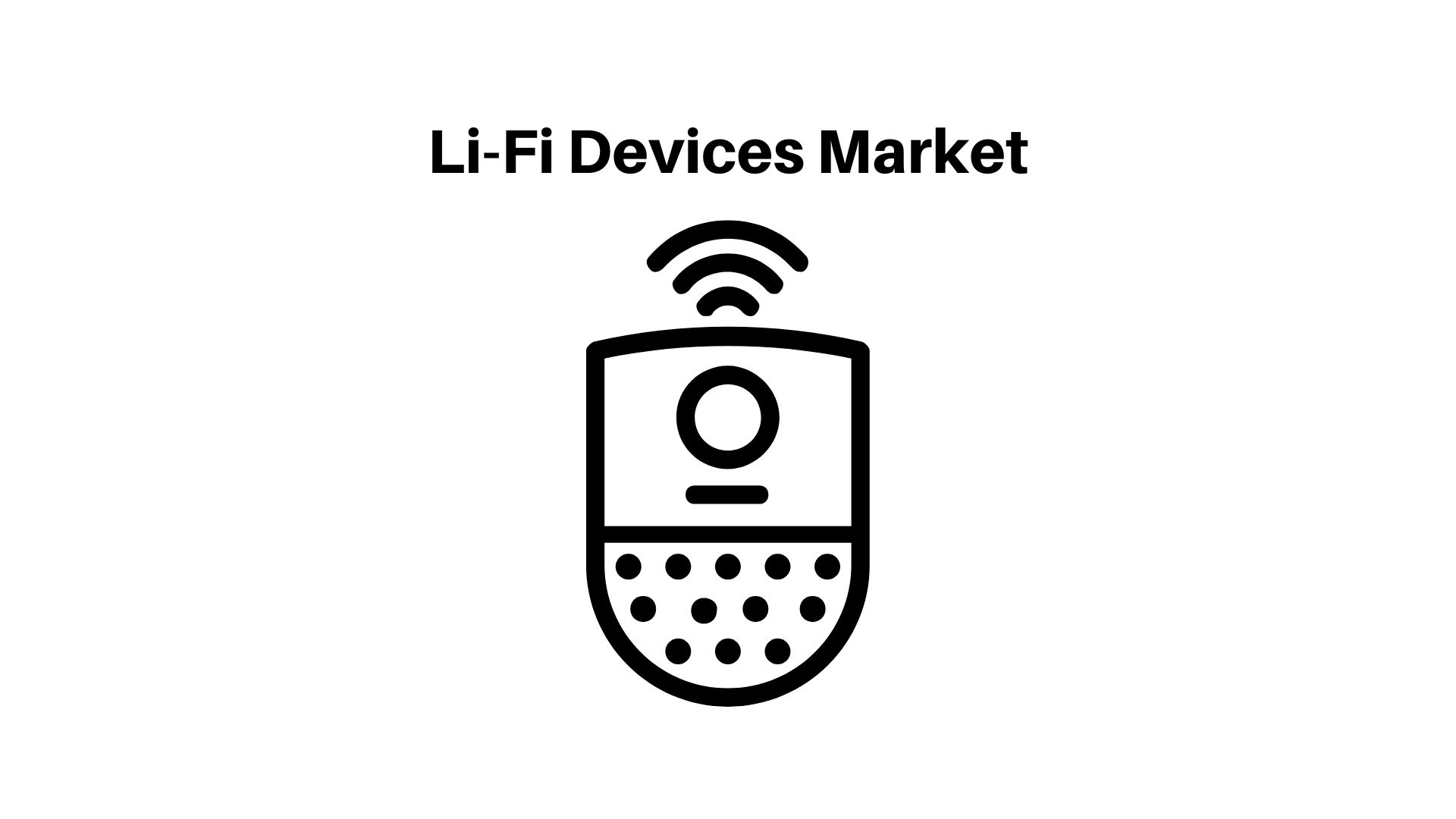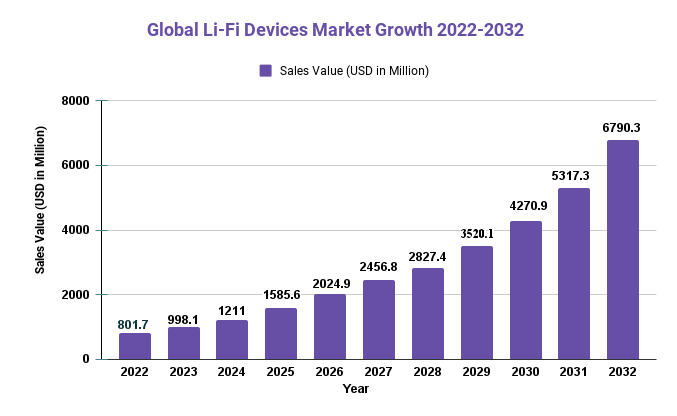Li-Fi Devices Market CAGR 24.5% by 2032 + Industry Landscape

Page Contents
Market Overview
Published Via 11Press: The Li-Fi (Light Fidelity) Devices market is a developing technology that utilizes visible light communication (VLC) to transmit data at high speeds. This market is expected to experience significant growth over the coming years due to increasing demand for speedy data transfers, the increasing adoption of the Internet of Things (IoT), and rising energy-saving lighting solutions. The market can be segmented based on component type, application, and region.
Li-Fi (Light Fidelity) is a wireless communication technology that utilizes light waves instead of radio frequencies as traditional Wi-Fi does. The global Li-Fi devices market is projected to reach a value of USD 6,790.3 million by 2032, expanding at an annual growth rate (CAGR) of 24.5% from 2022-2032. Though still relatively new, 5G wireless technology has already demonstrated some major advantages over traditional Wi-Fi, including faster speeds, greater bandwidth, and enhanced security. The market for Li-Fi devices is expected to experience significant growth over the coming years, driven by rising demand for high-speed wireless communication in various industries such as healthcare, retail, aviation, and transportation. Furthermore, Li-Fi technology's adoption in smart homes and smart cities is anticipated to further fuel the market development.
The market for Li-Fi devices is currently dominated by a few players, but competition is expected to increase as more companies enter it. Key market players include Acuity Brands, General Electric, LightPointe Communications, and pureLiFi. Asia-Pacific region is predicted to experience the fastest growth in this area due to the increasing adoption of smart city and IoT technologies in countries like China and India. North America and Europe also anticipate significant growth in this space due to increased demand for high-speed wireless communication across various industries.
Overall, the Li-Fi devices market is still developing and has immense growth potential over the coming years due to its advantages over traditional Wi-Fi and the growing demand for high-speed wireless communication across various industries.
Request For Sample Report Here: https://market.us/report/li-fi-devices-market/#requestSample

Key Takeaways
- The global Li-Fi Devices market is projected to experience significant growth over the coming years due to an increasing need for high-speed data transfer and energy-saving lighting solutions.
- The Li-Fi Devices market is segmented based on component type, application, and region.
- The major players operating in this space include PureLiFi, Signify, Acuity Brands, General Electric, Oledcomm, Panasonic Corporation, and LightBee Corporation.
Regional Snapshot
The Li-Fi Devices market is segmented into North America, Europe, Asia Pacific, Latin America, and the Middle East and Africa. The Asia Pacific region is expected to dominate this space due to increasing demand for high-speed data transfer, the growing adoption of Internet of Things (IoT) technology, and the presence of major players there. North America and Europe will also contribute significantly towards market growth due to their presence and increasing adoption of energy-saving lighting solutions.
Drivers
- Growing demand for high-speed data transfer: With the growing use of data-intensive applications, there is an increasing need for fast data transfers. Li-Fi technology offers faster data transmission than traditional Wi-Fi technology, driving the growth of this market.
- The growth of the Internet of Things (IoT) is driving demand for Li-Fi Devices, as it requires high-speed data transfer and energy-saving lighting solutions for connected devices.
- Rising Demand for Energy-Efficient Lighting Solutions: Li-Fi technology utilizes LED bulbs for data transfer, which are more energy-efficient than traditional bulbs. As a result, there is an increasing demand for energy-saving lighting solutions, fuelling the growth of this market.
Restraints
- Limited range: Li-Fi technology has a shorter range compared to Wi-Fi technology, creating an obstacle to market growth.
- Limited Adoption: Li-Fi technology is still in its early stages and has experienced limited adoption, which poses a major barrier to market growth.
- High Cost: The high cost of Li-Fi devices presents another major barrier to growth within this space.
Li-Fi (Light Fidelity) is a wireless communication technology that utilizes light waves instead of radio waves as traditional Wi-Fi does. Li-Fi devices have gained interest due to their potential advantages like higher data transfer rates, improved security, and reduced interference. In this response, we will cover the opportunities, challenges, recent developments, and FAQs related to Li-Fi devices' market share.
Opportunities
- High-Speed Data Transfer: Li-Fi devices offer much higher data transfer rates than traditional Wi-Fi, making them the ideal solution for applications requiring rapid data movements such as video streaming or virtual reality.
- Security: Li-Fi devices use light waves to transmit data, making them more secure than Wi-Fi which relies on radio waves that could be intercepted and hacked.
- Reduced Interference: Li-Fi devices are less susceptible to interference than Wi-Fi, as light waves do not interfere with other electromagnetic waves. This makes them a superior solution for applications where interference is an issue.
- Cost-Effectiveness: Li-Fi devices are expected to become more cost-effective as the technology spreads and production costs decline.
View Detailed TOC of the Report: https://market.us/report/li-fi-devices-market/table-of-content/
Challenges
- Limited Range: Li-Fi devices have a range of only the area illuminated by their light source, meaning they may not be suitable for applications requiring long-range communication.
- Interference from Ambient Light: Li-Fi devices are sensitive to ambient light, which may interfere with their signal. As such, they may not be suitable for use in environments with varying lighting conditions.
- Line-of-sight Communication: Li-Fi devices require a direct line of sight between the transmitter and receiver, meaning they may not be suitable for applications where obstacles stand between them.
- Integration with Existing Infrastructure: Li-Fi devices may necessitate major alterations to the current infrastructure, which could pose a barrier to adoption.
Recent Developments:
- Li-Fi technology is being explored for various applications, such as indoor navigation, smart lighting, and 5G networks.
- Researchers are developing Li-Fi devices that can operate outdoors, expanding the potential applications for this technology.
- Companies such as Signify (formerly Philips Lighting) and Velmenni are developing Li-Fi products for commercial use, indicating the growth of this market for Li-Fi devices.
Key Market Segments
Type
- LED Bulbs
- Lamps
- Wireless Devices
Application
- Transportation
- Healthcare
- Vehicles
- Aviation
Key Market Players
- PureLi-Fi
- Lucibel
- Oledcomm
- General Electric
- Osram
- Sunpartner Technologies
- Sunpartner Technologies
- Yuyang D & U
- Semicon Light
- Wipro
- Koninklijke Philips
- Panasonic Corporation
- Samsung Electronics
- Lemnis Lighting
- LG Electronics
- Lightpointe Communications
- FSOna Networks
- Bridgelux
- Toshiba Corporation
- Cree
Report Scope
| Report Attribute | Details |
| The market size value in 2022 | USD 801.7 Mn |
| Revenue forecast by 2032 | USD 6,790.3 Mn |
| Growth Rate | CAGR Of 24.5% |
| Regions Covered | North America, Europe, Asia Pacific, Latin America, and Middle East & Africa, and Rest of the World |
| Historical Years | 2017-2022 |
| Base Year | 2022 |
| Estimated Year | 2023 |
| Short-Term Projection Year | 2028 |
| Long-Term Projected Year | 2032 |
Frequently Asked Questions
Q: How fast is Li-Fi?
A: Li-Fi can deliver data transfer rates of up to several gigabits per second, which is much faster than traditional Wi-Fi.
Q: How Does Li-Fi Work?
Li-Fi utilizes light waves to transmit data, modulated for carrying information. The light signals are sent by LED bulbs which flicker on and off at high frequencies to create a binary code.
Q: Is Li-Fi Secure?
Yes, Li-Fi is more secure than Wi-Fi since light waves do not pass through walls and remain contained within a specific area, making it harder for hackers to intercept the signal.
Q: What are the potential applications of Li-Fi?
A: Li-Fi has numerous potential uses, such as indoor navigation, smart lighting, 5G networks, and high-speed data transfer for video streaming or virtual reality experiences.
Q: When will Li-Fi devices become widely available?
A: Unfortunately, Li-Fi products are still in their early stages and not yet widely available. Companies like Signify and Velmenni are developing products for commercial use, suggesting that demand is growing for these types of technology.
The team behind market.us, marketresearch.biz, market.biz and more. Our purpose is to keep our customers ahead of the game with regard to the markets. They may fluctuate up or down, but we will help you to stay ahead of the curve in these market fluctuations. Our consistent growth and ability to deliver in-depth analyses and market insight has engaged genuine market players. They have faith in us to offer the data and information they require to make balanced and decisive marketing decisions.



